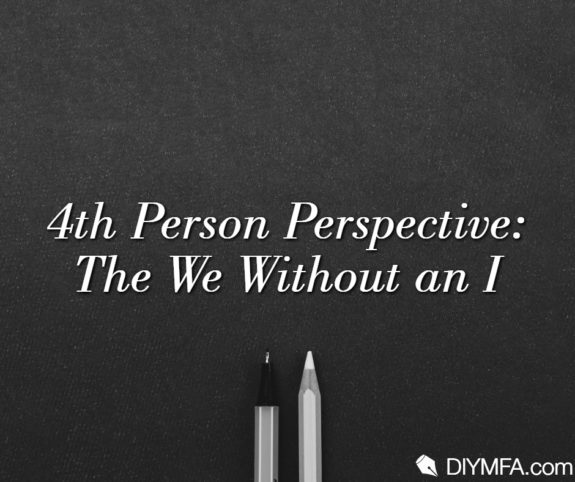The notion that we had an undiscovered perspective filled us with indescribable joy. For so long we’d lived with only three. Admittedly, our beloved 2nd Person had been chased away by middle school teachers and college composition courses, but we consoled ourselves with 1st and 3rd, made the most of them, and enjoyed our perspective scarcity. And suddenly We appeared, a perspective so estranged as to have been completely forgotten. We were reminded of childhood, when the world seemed limitless, before our view became constrained to I or Them. And yes, there were those who argued 4th was merely First Person Collective, and others who claimed it was a type of Third Super-Omniscience, but while there were similarities, the arguments didn’t hold up. It was clear 4th could do nearly everything first, second, and third could accomplish, and more—and for those of us who became 4th Person devotees, we knew we’d found an undiscovered perspective to explore.
Basic Cartography
The above is an example of what I call Traditional 4th Person Perspective. So, what exactly constitutes 4th Person (The We without an I) and how does it function? The basic premise of 4th is that we are telling a story/novel/poem from a collective’s perspective. This could be the voice of a corporate office (We here at BioTech believe we offer the best Robotic Children), a community (When we founded our commune, we hoped it would be a place of peace and brotherly/sisterly love), a niche social group (We were known as the Suburban Avengers and we wrestled every weekend in Don’s garage), or even a group of animals (At night we sniff at garbage cans and test out the lids with our claws).
The key to the perspective is that the narrative voice encompasses a larger group and uses the narrative voice to speak collectively for them, avoiding ever using a central 1st person “I.”
The Difference from 1st Person Collective
A good way to understand how 4th works is to examine its difference from 1st Person Collective (wherein the “We” has a clearly defined first person narrator). Here are a couple examples of what first person collective sounds like:
When our mother took us swimming, she’d sit on the beach drinking martinis from her Thermos while she watched us. We sisters would swim beyond the crashing waves, and my older sisters would swim so far that I worried we’d never return.
We’re the Rocket Launchers and our mission is to build rockets to the moon. Donnie and Larry are twin brothers, and they get to come over as long as they bring gloves and winter coats. Petey’s mom never seems to care where he is, so he brings the gasoline from her shed. And I’m the one with access to gunpowder.
While the use of “we” and “our” can be a prominent feature, beneath the voice of 1st Person Collective is an “I” narrator that controls the tone/voice/language of the piece. Like all first person perspectives, the story/novel will be determined and limited to the attitude, age, experiences, and knowledge of the narrator. In this way the scope of the known world is limited. For example, in the rocket story, the narrator cannot omnisciently follow any of the children back to their homes or report on the dialogue that happens there unless the narrator literally follows them home or is later told this information (or is psychic!).
4th Person is inherently different because there is no limited “I.” Instead, in 4th, the tone is influenced by the collective voice of the community/group but not hampered by it. Here are some examples of what 4th sounds like:
When the neighbors moved in, we wondered if they belonged in our community. We think of ourselves as a welcoming community. We bake pies, help one another paint our houses every couple years, and, mostly, have never uttered an unkind word about anyone. But when we saw the neighbors arriving with their run-down car and their ugly children, we watched from our gardens and decided not to wave.
When the broomsticks appeared outside our bedroom windows, our hearts lifted like hot-air balloons. The women tapped gently on our windows, and we crept from beneath the sheets, tiptoed carefully across the carpet so as not to wake our parents, and climbed across sills, reaching through the cold air to grasp the wooden handles.
In the first example, the creepiness of the community leaks into the very voice of the telling. In the second example, the awe of the children imbues the narrative voice. In this way, 4th has the option of being tonally colored by the collective voice of the group. Most importantly, it will be this “we” that will tell the story of the community rather than any individualized “I” from within that group.
4th’s Omniscient Range
And yet, 4th doesn’t need to be limited by the voice of the community. One of the wonderful benefits to 4th is that while the voice may be imbued by the community, it is not tied to any individual consciousness. In the broomstick example above, though the children are young, the narrative voice and language doesn’t need to be limited to the linguistic limitations of the children. For example:
We sailed above the land, and the houses below became faded postage stamps, obscured by the thin fingers of clouds and the frosts of the North which arrived early that year. Far below, in the chilled suburban dawn, men and women started their cars, clueless to the broomsticks which soared high above.
The language here is clearly beyond that of a child’s vocabulary, and yet this feels completely natural in 4th person.
Similarly, the known scope of the world can extend beyond the collective’s knowledge, becoming a more distant omniscient:
At home, our parents were waking up. “Have you seen the kids?” our fathers asked, yawning in kitchens, their coffee mugs in hand. And they searched beneath beds, in closets, and finally, with panic in their voices, called police and firemen.
Like a mole digging tunnels beneath the ground, the omniscience of 4th allows your narrative camera to pop up in any of the collective’s presence:
At night we complained about the neighbors. Tom, who owned the hardware store, would pour himself a tall glass of bourbon. “I don’t trust them,” he said to his wife. “I know,” she said, and put down her knitting, then lowered her voice in case anyone was listening. “I think they’re dangerous.” Across town, The Woodstone’s were having their own private conversations. “Maybe we should pay them a visit?” Mr. Woodstone said.
In fact, the voice is so omniscient, that unlike 1st Person, it’s possible for the “we” to die in a story:
When we grew old, we closed our eyes, squeezed the hands of our loved ones, and soon we were buried. And we gathered to say goodbye to those we’d lost, and gathered afterward to watch the young among us, the next generation, who we knew would one day bury us.
In this way 4th borrows the best attributes of interiority from 1st with the best aspects of 3rd omniscience. The combined range of intimacy and expansive omniscience is part of what makes 4th such a wonderful perspective.
The Challenges of Dialogue & Movement
There are a few limitations to navigating 4th smoothly. Movement and speech, for example, can become strangely cartoonish if we aren’t careful.
We decided to walk over and confront the neighbors. “Open up!” we yelled.
In this scene the entire group is now congregating and yelling outside the house in a near-comic fashion. To solve this problem requires splitting the “We” into smaller groups:
A few of us decided to confront the neighbors. Tom, his wife Rhonda, and The Woodstone’s were the first to go. “We baked you cookies,” Rhonda said when the neighbors opened the door. “You mind if we come in,” Mr. Waterstone added quickly.
Another way to avoid the problem of strange collective moments such as: we went to the bathroom; we rode the escalator; or we honked our horn is to create a list of simultaneous actions:
We baked cookies, we offered to paint their house or to babysit their kids, we made small talk when we saw them at the hardware store, and late at night we called one another and told tales of what we’d seen. We plotted, we lamented, and finally, we gave up trying to be nice.
Additional Variations
There are strange and wonderful variations within the new perspective. In 4th Person Address there is a “We” addressing a “You.” This is a particularly fun point of view that allows two of the black sheep of the literary family (4th and 2nd) to finally have the long-deserved page space they deserve.
Welcome to BioTech, we know you will enjoy your time here as part of The Future of America! You will soon become one of our elite Robot Engineers, helping bridge the divide between human and machine. We couldn’t be happier to have you with us!
There’s the rare and strange variation of 4th Person Address that I call the Christmas-Card Perspective—wherein a couple is using the “we” voice without ever identifying themselves:
We are doing well, keeping busy here: Sarah is working on her teaching degree, and Bob is finally fixing the garage.
And there’s The Passive-Aggressive-Therapy Perspective:
Sure, we’re a caring couple. Though, admittedly, sometimes one of us forgets to clean their hair out of the shower drain and then the other one of us has to do that, even though that someone is already late for work.
How to Begin
If you’re interested in exploring our new perspective, it’s good to check out any of the stories below. Then consider how often we use 4th Person in our daily lives (that sentence, by the way, was 4th Person Address). Think of all the boring company meetings and job trainings you’ve had to sit though, the way we talk about our families, our friend groups, our hometown, our favorite sports teams, our age group, our genders, class, race, or the tiny cliques we may be part of (We’re a post-pop, psychedelic-folk band). Create an initial list of all the examples where you find “we” used. Then choose one and explore a story/novel/essay/poem from this new perspective.
Resources from my work and others
Two stories from my recent collection, Universal Love (Sanctuary & We Only Wanted Their Happiness) use the traditional 4th Person Perspective.
My recent Tour Guide Series is all in 4th Person Address
Steven Millhauser is a master of Traditional 4th Person—check out his wonderful collection The Knife Thrower and Other Stories.
Amber Sparks collections The Unfinished World & And I Do Not Forgive You both have a number of variations on 4th.
One of the most successful forms of The Passive-Aggressive Therapy Perspective is John Barth’s story “Waves,” by Amien Richard from his collection On With the Story.
There are hundreds of other examples and new 4th Person stories are emerging every year. Feel free to add to the list, and send along your favorites to me at https://www.alexanderweinstein.com/

Alexander Weinstein is the author of the collections Universal Love and Children of the New World, which was chosen as a New York Times Notable Book of the Year, and a best book of the year by NPR, Google, and Electric Literature. His fiction and interviews have appeared in Rolling Stone, World Literature Today, Best American Science Fiction & Fantasy, and Best American Experimental Writing. He is the founder and director of The Martha’s Vineyard Institute of Creative Writing and a Professor of Creative Writing at Siena Heights University.







